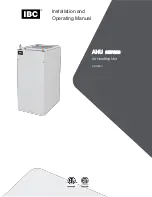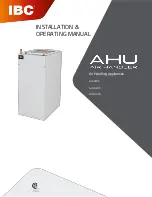
20
TABLE 7
6.
MAINTENANCE
6.1.
FOREWORD
TCF recommends that its customers carry out preventive
maintenance on the Air Treatment Units in order to
ensure long-term efficiency. These units require little
maintenance and have been designed to make each
operation as easy and safe as possible.
6.2.
FILTRATION SECTIONS
The filtration sections require the most frequent
maintenance in order to:
- ensure that the air is filtered with the required efficiency
in the conditioned environment
- to prevent unit components from being damaged.
6.2.1. Reconditionable synthetic filters
These are cells measuring 50 or 1 O0 mm in thickness,
also known as PREFILTERS, which offer the advantage of
being reconditionable. The RECONDITIONING can be
performed using two different methods, depending on the
type of dust treated:
- In the case of DRY DUSTS, a compressed air jet is
directed against the filter in the opposite direction to
normal operation.
- In the case of WET DUSTS, the filtration diaphragm is
washed (without removing it from the frame), if
necessary using domestic detergents.
To avoid damaging the filter the temperature of the water
must not exceed 50°C. Do not use solvents or caustic soda.
Let the diaphragm dry by evaporation and refit it only
when it is perfectly dry.
TCF advises you to CHECK THE CONDITION OF THE
FILTERS ON A WEEKLY BASIS.
THE PREFILTERS MUST BE RECONDITIONED EVERY 7-
20 DAYS depending on the type of environment being
conditioned. After 7-10 reconditioning operations, the
diaphragm deteriorates and its original characteristics
will be impaired; it should therefore be replaced.
6.2.2. Metal filters
These are filters of considerable strength and long service
life (especially if the mesh is stainless steel). You should
inspect them visually to decide when they need replacing.
THESE FILTERS MUST BE RECONDITIONED AT LEAST
ONCE A WEEK since they generally treat extremely
impure air (greasy and highly laden with particles).
The RECONDITIONING consists in washing the filters, if
necessary with solvents and caustic soda mixtures.
The filtration diaphragm may be dried with warm air or
compressed air.

































